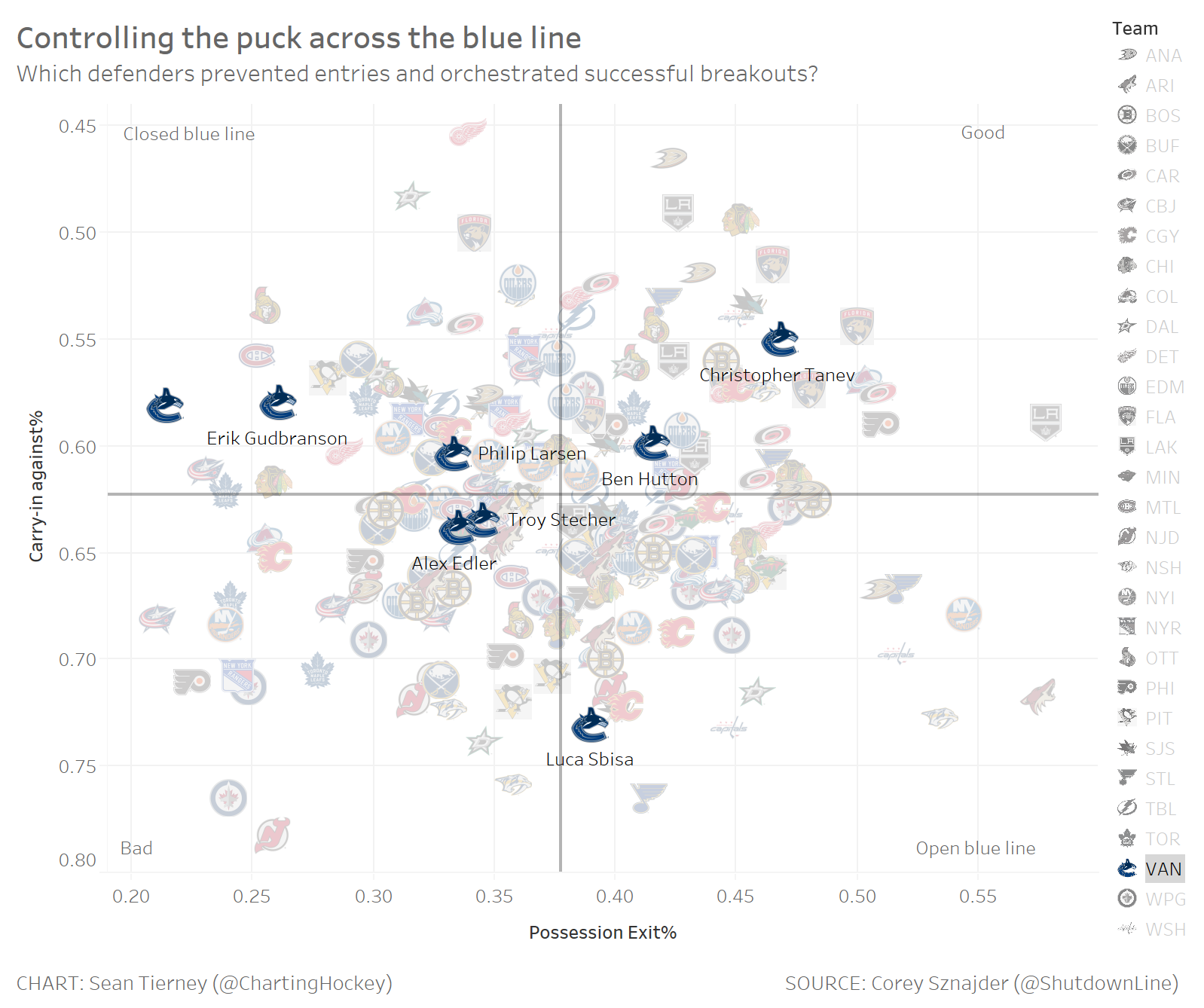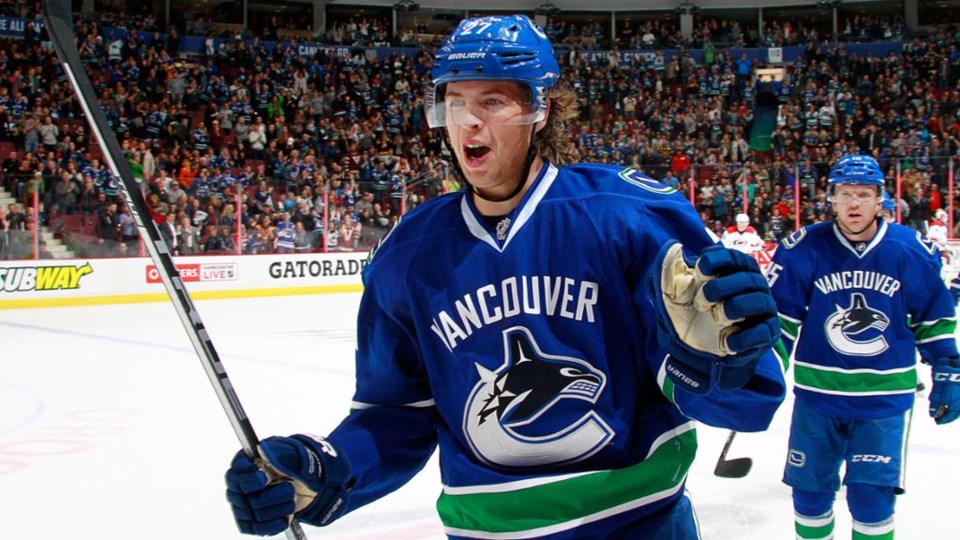The Canucks 2017-18 season won’t hinge on any one player, but some are more important than others. The Canucks need continued progression from Bo Horvat; they need two wingers who can help make Horvat’s line a legitimate first line; they need one of Jacob Markstrom or Anders Nilsson to seize the starting job in net; they need Loui Eriksson to bounce back from his rough first season; they need the Sedins to halt their regression and provide secondary scoring.
But there is one key player who could make a significant difference at even-strength, on the power play, and on the penalty kill. Apart from the two goaltenders, the performance of Ben Hutton might be the key factor that determines the success of the Canucks next season.
That may seem like a bold claim, but no other player on the Canucks provides as much of an impact in all situations as Hutton. Considering his development path, that should come as a surprise.
In the 2012 entry draft, the Canucks selected just one player who was in his first year of draft eligibility: Brendan Gaunce in the first round. After Gaunce, Mike Gillis and the Canucks took a big risk, selecting four players who were each at least 19 years old and had already passed through the draft at least once.
There is always a risk in selecting older players in the draft as there is usually a reason they went undrafted and their added experience, training, and size can make them stand out amongst their younger teammates and opponents in a way that can fool scouts. For the most part, those concerns were realized in the Canucks’ picks.
The 20-year-old Alexandre Mallet was a big reach in the second round and he wound up in the ECHL for a few seasons before heading overseas to play in the Czech Extraliga. Likewise, Wes Myron ended up in the ECHL for a few injury-riddled seasons before retiring from hockey and . Matthew Beattie didn’t even make it to the ECHL, choosing to instead play professional hockey in France after a few underwhelming years at Yale, including a senior year wiped out by a season-ended injury.
Hutton, however, salvaged the Canucks’ approach at the 2012 draft. After a few strong seasons in the NCAA, Hutton was a revelation at his first ever NHL training camp, making the Canucks right out of camp. He finished third among rookie defencemen in points, second in assists, and third in time on ice. He even played for Team Canada at the World Championships.
But last season, things went a little sideways. He took a step back from his 25-point rookie season, putting up 19 points. He struggled alongside his new defence partner, Erik Gudbranson, and Gudbranson seemed to pin the blame on Hutton, , “He has less than 100 games and it takes 300 to learn to defend well.”
Here’s the thing: Hutton was not as bad defensively last season as you (or Gudbranson) might think. At 5-on-5, Hutton’s numbers don’t look great at first. Hutton had the worst goal differential among all Canucks defencemen and his corsi percentage ended up in the middle of the pack.
It’s important to keep in mind who he played with, however: the vast majority of his minutes came alongside Gudbranson and Nikita Tryamkin and neither of those two defencemen gave him much to work with. Gudbranson has long been a corsi anchor, while the excitement about Tryamkin had a lot more to do with his potential than his actual performance this past season.
When you look at just his defensive numbers, Hutton stands out: he was on the ice for 53.69 shot attempts against per hour and the only Canucks defenceman who allowed a lower rate of shot attempts against was Chris Tanev. Any time you can find a way to be compared to Tanev defensively, you’re in good company.
Among 236 defencemen who played at least 200 minutes at 5-on-5 last season, that shot attempt against rate places Hutton 82nd. Even if he’s not top-30 like Tanev, that’s still well above average.
Hutton’s goal differential largely suffered not because of the Canucks’ defensive numbers when he was on the ice, but because of the offensive numbers. To understand why those numbers suffered when Hutton is supposed to be an offensive defenceman, you just have to look over at Gudbranson and Tryamkin.
That’s not to put all the blame on his partners, but it’s hard to avoid, particularly when you see their struggles at zone exits.
Hutton was one of the Canucks’ most effective defenceman at preventing zone entries by the opposition and enabling zone exits for the Canucks. While Tanev leads the Canucks defence in zone exits with possession according to data gathered by Corey Sznajder, Hutton is the next best breakout option, using his plus skating and good first pass to get the puck out over the blue line.

��
That’s particularly impressive when you look at where Hutton's partners land on the above chart: Gudbranson and Tryamkin are on the far, far left, as they were the Canucks’ two worst defencemen at zone exits with possession, with both more likely to dump the puck out, ice it, or fail to get it out altogether. That placed the burden of moving the puck up ice almost solely on Hutton’s shoulders.
Hutton’s ability to move the puck up ice will be key next season, as it’s one of the main issues that stifled the Canucks’ offence last season. If he can be matched with Tanev or Troy Stecher instead of Gudbranson, that would likely help, or the Canucks can hope that Gudbranson improves with a healthy wrist.
Where Hutton could have an even bigger impact is on special teams, where the Canucks hope to improve from their near worst-in-the-league finish last season.
Let’s start with the power play, where you could argue that Hutton is the power play quarterback the team has been looking for.
He certainly wasn't used that way: Hutton was fourth among Canucks defencemen in average ice time with the man advantage, behind Stecher, Alex Edler, and Philip Larsen. Among all skaters, he was eighth in average ice time, with the bulk of that time coming with the second power play unit.
That may have been a mistake, as Hutton led the Canucks in power play points per hour, with 4.54. He finished with 11 power play points, just short of twice as many as Stecher, who got the plum position on the first unit. There’s an argument to be made that Hutton should have been quarterbacking the power play with the Sedins last season despite being a left-hand shot.
That production is particularly impressive when you consider how the second power play unit is usually deployed: they frequently come onto the ice on the fly after the puck has been cleared, so they don’t get the benefit of an offensive zone faceoff, but have to break out, gain the offensive zone, and then set up a power play formation with possession.
Hutton should certainly get more ice time on the power play next season, though that doesn’t necessarily mean playing with the Sedins. Horvat was second behind Hutton on the Canucks last season in power play point production, so both should get a boost in ice time and potentially get treated as the foundation of a new first unit.
And then there’s the penalty kill. Hutton barely got used shorthanded last season, averaging just 32 seconds per game on the penalty kill, which was seventh among Canucks defencemen.
Three of the defencemen ahead of him won’t be, or are unlikely to be, in the lineup next season. Luca Sbisa was claimed by the Vegas Golden Knights, Tryamkin bolted for the KHL, and Alex Biega is likely bound for the Utica Comets. Someone will need to step up to play on the penalty kill and, while the Canucks added Michael Del Zotto and Patrick Wiercioch who can both play that role, the numbers suggest Hutton should get a lot more use shorthanded.
Of the Canucks who played at least 20 minutes shorthanded last season, Hutton was on the ice for the lowest rate of shot attempts against and unblocked shot attempts against. He led all defencemen with the lowest rate of shots on goal against and scoring chances against, as tracked by .
There’s a caveat similar to the one above about him being on the second power play unit: because he frequently came onto the ice for the penalty kill on the fly instead of starting with a defensive zone faceoff, Hutton had the advantage of facing a power play that needed to get over the blue line and get set up with possession. That leads to a lower rate of shots and shot attempts.
Even with that in mind, Hutton’s numbers suggest he should be in the regular shorthanded rotation. He could take Sbisa’s spot and, considering Sbisa had the highest rate of shots on goal against and goals against among Canucks defencemen, that could lead to a significant improvement on the penalty kill.
When you put those three situations together — 5-on-5, power play, and penalty kill — it becomes clear just how important Hutton will be next season. His ability to move the puck up ice and be an offensive option for his forwards will impact how much the Canucks score at even-strength; his ability to quarterback a power play and suppress shots on the penalty kill will impact the effectiveness of the Canucks’ special teams.
The key, however, will be Travis Green and how much trust the new Canucks head coach places in the 24-year-old Hutton.



